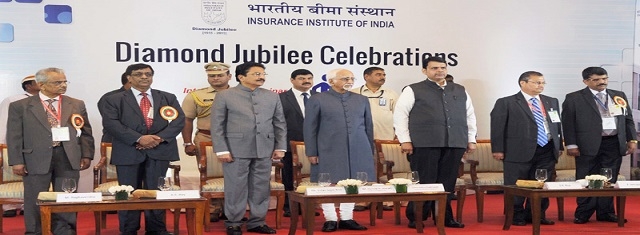News
Insurance Can Mitigate The Economic Impact Of Events, Says Vice President
Insurance Institute Of India

Diamond Jubilee celebrations. (Source: PIB/GR/TYP/BIN/USPA/WN)
USPA NEWS -
Vice President, Mr. Mohd. Hamid Ansari at valedictory function of the Diamond Jubilee celebrations of Insurance Institute of India, in Mumbai on August 26, 2015. Governor of Maharashtra, Mr. C. Vidyasagar Rao, Chief Minister of Maharashtra, Mr. Devendra Fadnavis and other dignitaries are also seen.
The Vice President of India Mr. Mohd. Hamid Ansari said that Insurance can mitigate the economic impact of events like illness, death, disability, fire, theft, and natural disaster on individuals, households, or enterprises. In doing so, insurance helps people avoid destitution, regularizes their consumption, protects their assets, and allows them to pursue high-return economic activities and make investments.
Addressing at the at the “˜Diamond Jubilee celebrations of the Insurance Institute of India, Mumbai´ in Mumbai on August 26, the Vice President said that increasing the access of poor households to insurance mechanisms will prevent them from having to rely on publicly funded support systems. It can encourage them to adopt alternative, more productive livelihoods ““ for example, planting higher-yield crops insured against the risk of drought- that can help to lift them out of poverty. This would also enable the government to target scarce public resources at the poorest so that a higher share of poor households is covered by the public social protection system.
He opined that in this way, insurance is a useful strategy on a continuum of risk management options. Ensuring that poor households have access to insurance services should be priority for us in India.
The Vice President said that the Government of India has created policies to promote financial inclusion and extend insurance cover to the poor through schemes such as the Pradhan Mantri Jan-Dhan Yojana, the Pradhanmantri Suraksha Beema Yojana and the Pradhanmantri Jeevan Jyoti Beema Yojana. The Finance Minister has indicated that the government plans to cover at least 40 per cent of the population using the plans launched under the three social security plans, which includes life insurance, accident cover and a pension scheme.
The Vice President said that the Government of India has created policies to promote financial inclusion and extend insurance cover to the poor through schemes such as the Pradhan Mantri Jan-Dhan Yojana, the Pradhanmantri Suraksha Beema Yojana and the Pradhanmantri Jeevan Jyoti Beema Yojana. The Finance Minister has indicated that the government plans to cover at least 40 per cent of the population using the plans launched under the three social security plans, which includes life insurance, accident cover and a pension scheme.
The Vice President said the schemes come at nominal premium. The off-take for the schemes has been encouraging, but beyond the government action, the current industry structures and economic models are not yet conducive to its large scale success. The main challenge is to encourage poor households to invest in insurance, as one of a menu of social protection instruments, he said.
He said that Micro-insurance for life, agriculture and health coverage of the economically disadvantaged sections is a possible alternative but its prevalence in India remains low and will remain so until the insurers go beyond the traditional distribution models. For micro-insurance to succeed, demand has to be generated through building awareness, rationalizing the subscription costs to income levels and creating specific and simple products, and above all, by simplifying the processes of underwriting and claims management.
The Vice President said that the lack of equitable participation in the India growth story is of concern to the Government and financial services regulators. However, financial inclusion, including in the insurance sector, is an expensive proposition. For financial inclusion to succeed, it must evolve from being a social or regulatory obligation into a viable business proposition. The need is to employ emerging technologies, generate awareness by increased financial education of masses and move beyond traditional products to shift from a cost-centric model to a win-win revenue generating model that provides quality financial services on a sustainable basis to the economically disadvantaged.
Liability for this article lies with the author, who also holds the copyright. Editorial content from USPA may be quoted on other websites as long as the quote comprises no more than 5% of the entire text, is marked as such and the source is named (via hyperlink).





